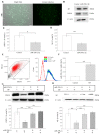Targeting PSEN1 by lnc-CYP3A43-2/miR-29b-2-5p to Reduce β Amyloid Plaque Formation and Improve Cognition Function
- PMID: 36142465
- PMCID: PMC9506169
- DOI: 10.3390/ijms231810554
Targeting PSEN1 by lnc-CYP3A43-2/miR-29b-2-5p to Reduce β Amyloid Plaque Formation and Improve Cognition Function
Abstract
Presenilin-1 (PSEN1) is a crucial subunit within the γ-secretase complex and regulates β-amyloid (Aβ) production. Accumulated evidence indicates that n-butylidenephthalide (BP) acts effectively to reduce Aβ levels in neuronal cells that are derived from trisomy 21 (Ts21) induced pluripotent stem cells (iPSCs). However, the mechanism underlying this effect remains unclear. This article aims to investigate the possible mechanisms through which BP ameliorates the development of Alzheimer's disease (AD) and verify the effectiveness of BP through animal experiments. Results from RNA microarray analysis showed that BP treatment in Ts21 iPSC-derived neuronal cells reduced long noncoding RNA (lncRNA) CYP3A43-2 levels and increased microRNA (miR)-29b-2-5p levels. Bioinformatics tool prediction analysis, biotin-labeled miR-29b-2-5p pull-down assay, and dual-luciferase reporter assay confirmed a direct negative regulatory effect for miRNA29b-2-5p on lnc-RNA-CYP3A43-2 and PSEN1. Moreover, BP administration improved short-term memory and significantly reduced Aβ accumulation in the hippocampus and cortex of 3xTg-AD mice but failed in miR-29b-2-5p mutant mice generated by CRISP/Cas9 technology. In addition, analysis of brain samples from patients with AD showed a decrease in microRNA-29b-2-5p expression in the frontal cortex region. Our results provide evidence that the LncCYP3A43-2/miR29-2-5p/PSEN1 network might be involved in the molecular mechanisms underlying BP-induced Aβ reduction.
Keywords: Alzheimer’s disease; Presenilin1; miR-29b-2-5p; n-butylidenephthalide; β-amyloid plaque.
Conflict of interest statement
The authors declare no conflict of interest.
Figures






Similar articles
-
Novel presenilin 1 and 2 double knock-out cell line for in vitro validation of PSEN1 and PSEN2 mutations.Neurobiol Dis. 2020 May;138:104785. doi: 10.1016/j.nbd.2020.104785. Epub 2020 Feb 4. Neurobiol Dis. 2020. PMID: 32032730 Free PMC article.
-
MicroRNA-339-5p down-regulates protein expression of β-site amyloid precursor protein-cleaving enzyme 1 (BACE1) in human primary brain cultures and is reduced in brain tissue specimens of Alzheimer disease subjects.J Biol Chem. 2014 Feb 21;289(8):5184-98. doi: 10.1074/jbc.M113.518241. Epub 2013 Dec 18. J Biol Chem. 2014. PMID: 24352696 Free PMC article.
-
MiR-335-5p Inhibits β-Amyloid (Aβ) Accumulation to Attenuate Cognitive Deficits Through Targeting c-jun-N-terminal Kinase 3 in Alzheimer's Disease.Curr Neurovasc Res. 2020;17(1):93-101. doi: 10.2174/1567202617666200128141938. Curr Neurovasc Res. 2020. PMID: 32003672
-
Evidence For and Against a Pathogenic Role of Reduced γ-Secretase Activity in Familial Alzheimer's Disease.J Alzheimers Dis. 2016 Apr 4;52(3):781-99. doi: 10.3233/JAD-151186. J Alzheimers Dis. 2016. PMID: 27060961 Review.
-
Genes and mechanisms involved in beta-amyloid generation and Alzheimer's disease.Eur Arch Psychiatry Clin Neurosci. 1999;249(6):266-70. doi: 10.1007/s004060050098. Eur Arch Psychiatry Clin Neurosci. 1999. PMID: 10653281 Review.
Cited by
-
Role of Bioactive Molecules on Neuroprotection, Oxidative Stress, and Neuroinflammation Modulation.Int J Mol Sci. 2022 Dec 14;23(24):15925. doi: 10.3390/ijms232415925. Int J Mol Sci. 2022. PMID: 36555565 Free PMC article.
-
Alterations of mRNAs and Non-coding RNAs Associated with Neuroinflammation in Alzheimer's Disease.Mol Neurobiol. 2024 Aug;61(8):5826-5840. doi: 10.1007/s12035-023-03908-5. Epub 2024 Jan 18. Mol Neurobiol. 2024. PMID: 38236345 Review.
-
Exosomes and non-coding RNAs: bridging the gap in Alzheimer's pathogenesis and therapeutics.Metab Brain Dis. 2025 Jan 4;40(1):84. doi: 10.1007/s11011-024-01520-7. Metab Brain Dis. 2025. PMID: 39754674 Free PMC article. Review.
-
Long Non-Coding RNAs: Crucial Regulators in Alzheimer's Disease Pathogenesis and Prospects for Precision Medicine.Mol Neurobiol. 2025 Jun;62(6):7525-7541. doi: 10.1007/s12035-025-04729-4. Epub 2025 Feb 5. Mol Neurobiol. 2025. PMID: 39907902 Review.
-
n-Butylidenephthalide recovered calcium homeostasis to ameliorate neurodegeneration of motor neurons derived from amyotrophic lateral sclerosis iPSCs.PLoS One. 2024 Nov 7;19(11):e0311573. doi: 10.1371/journal.pone.0311573. eCollection 2024. PLoS One. 2024. PMID: 39509425 Free PMC article.
References
-
- Roher A.E., Lowenson J.D., Clarke S., Woods A.S., Cotter R.J., Gowing E., Ball M.J. beta-Amyloid-(1-42) is a major component of cerebrovascular amyloid deposits: Implications for the pathology of Alzheimer disease. Proc. Natl. Acad. Sci. USA. 1993;90:10836–10840. doi: 10.1073/pnas.90.22.10836. - DOI - PMC - PubMed
-
- Chang C.Y., Chen S.M., Lu H.E., Lai S.M., Lai P.S., Shen P.W., Chen P.Y., Shen C.I., Harn H.J., Lin S.Z., et al. N-butylidenephthalide attenuates Alzheimer’s disease-like cytopathy in Down syndrome induced pluripotent stem cell-derived neurons. Sci. Rep. 2015;5:8744. doi: 10.1038/srep08744. - DOI - PMC - PubMed
MeSH terms
Substances
Grants and funding
LinkOut - more resources
Full Text Sources
Medical

